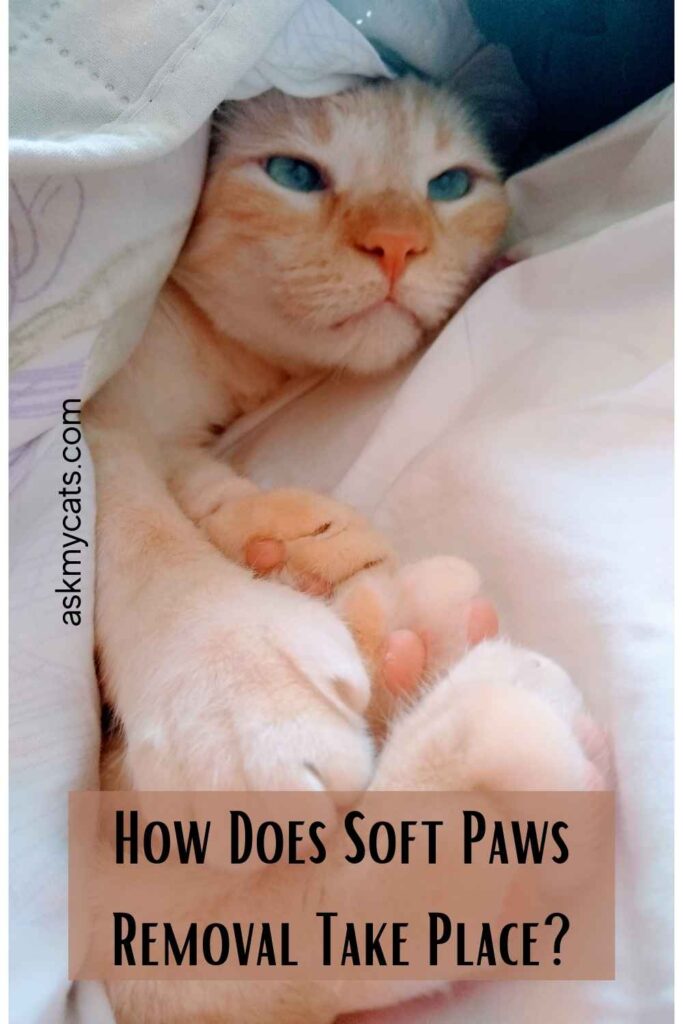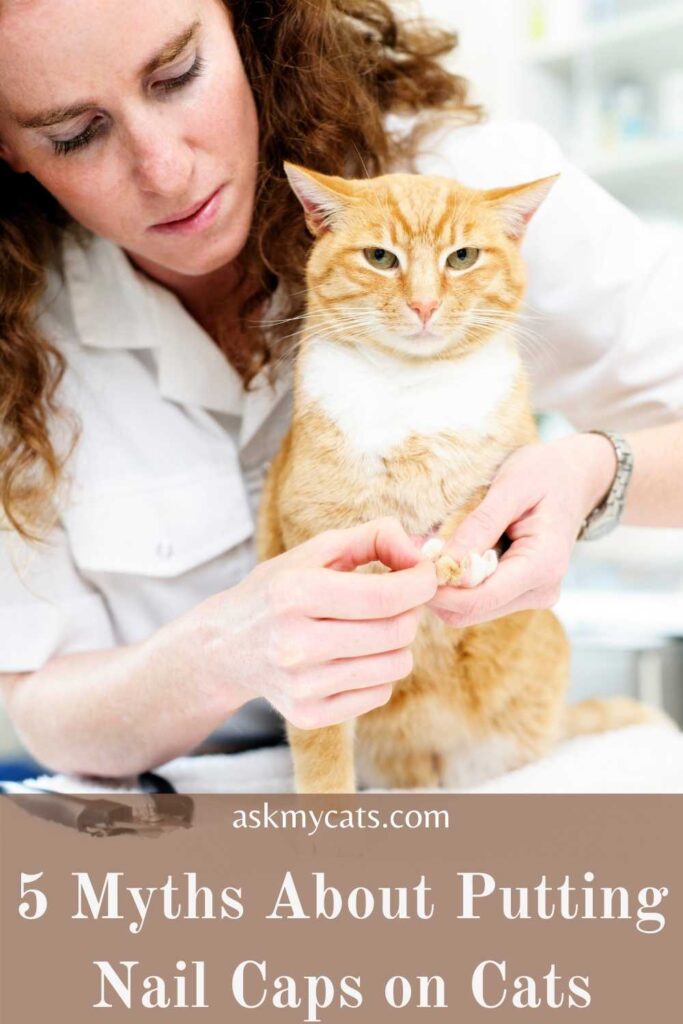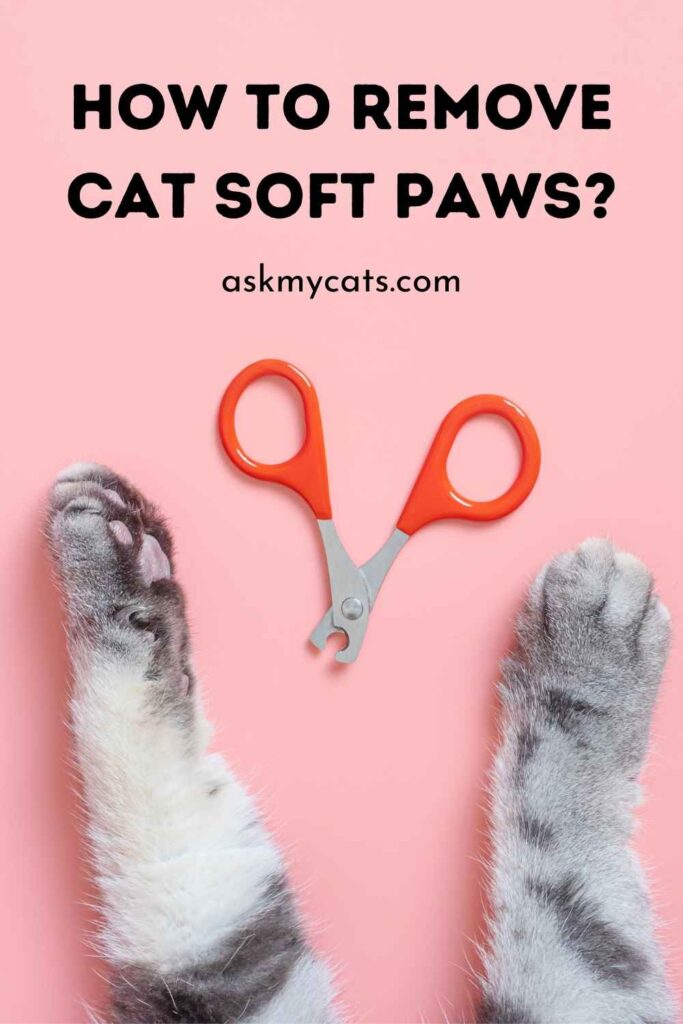Declawing cats is often misunderstood as a harmless “easy fix” for excessive scratching. They don’t know that declawing a cat makes it less possible for it to use the litter box or bite.
Declawing the pet will also result in long-term health issues. Declawing is prohibited in many nations.
You may proceed by clipping the ends of the Soft Paw caps with claw clippers to sever the seals, leaving vinyl “tubes” across the cat’s claws.
Trim carefully and just a little at a time, as with a cat’s natural nails, to prevent puncturing the pink tissue, or “fast,” which would result in bleeding.


Give Your Cat the Perfect Day
Get the Free Ebook!
How Does Soft Paws Removal Take Place?
The Soft Paw Removal process in cats is a natural process.

The layers of a cat’s nails are close to the layers of an onion. The sheath, or outer coat, is shed every 4-6 weeks.
During this shedding process, the Soft Paws nail caps will usually come off.
The Soft Paw normally starts coming off by 6-8 weeks, despite the fact that a dog’s nail does not develop as fast as a cat’s.
If your cat or dog’s nail caps haven’t fallen off after 8 weeks, you can manually loosen them by trimming the top of the nail cap, being careful not to cut into the easy, and then gently massaging the base of the nail cap.
The adhesive bond should be broken, and the nail cap should come right off. If this may not crack the adhesive bond, you will need to scrape the Soft Paws with a tiny pair of cuticle scissors.
Trying to pry the scissors between the nail cap and the nail is a bad idea.
To make an opening from the rim of the nail cap to the base, simply put the scissors flat against the top of the nail cap and trim away at the vinyl cap.
Peel the cap away from the nail as if “butterflying” it until you’ve made the gap, as seen in the pictures. Please note that although the images show a dog, the same procedure can be used for a cat:
If all of the Soft Paws have been removed, start applying a new pair by filling your nail caps 1/3 full with adhesive and pressing them between your fingers to uniformly spread the adhesive.
Finally, apply the Soft Paws to your pet’s nail and wait five minutes before releasing them.
You might also like to read about cat can't retract claws
5 Myths About Putting Nail Caps on Cats

1. Nails Are Prohibited From Retracting
It’s unquestionably a myth! When a cat’s nail expresses and then retracts, it does not go up into the paw.
When a cat relaxes and retracts its claws, it stops the claws from contacting the ground while walking.
The cat’s paws and claws will make all of the same normal motions when wearing nail caps as they can without them.
As long as the nail caps are applied correctly, which means being the correct size for the cat’s nail, having the nail clipped prior to application, and using only enough glue to adhere, the nails can easily stretch and withdraw.
2. Cause Damage To The Nail And Nail Bed
A veterinarian designed the Soft Paws brand to be gentle and non-toxic to both cats and dogs. There should never be any injury or pain to the cat’s paws or nail beds if the nail caps are applied properly.
The correct implementation involves selecting a nail cap size and shape that is comfortable for each cat’s nails.
Using just enough glue to hold it together, but not so much that it overflows during application. The adhesive does not come into contact with the cat’s fur, nail bed, or the skin around the claws.
Trimming the nail marginally longer than normal (just below the ‘hook’) and leaving space between the nail cap and the cat’s nail bed.
You would like to read about what to do if cat nail bleeding after cutting
3. Scratching Posts Can Be Used In Lieu of Nail Caps
Scratching posts are a great choice for many cats because they encourage them to stretch and flex, offer an alternative to scratching furniture, carpets, and window curtains, and allow them to mark their territories with scent from their paws.
Scratching posts, contrary to popular belief, do not “file down” a cat’s claws, making them less sharp. They assist the cat in removing dead layers of the nail sheath to expose fresh, sharp nails underneath.
Scratching posts can help keep cat nails healthy, but they are also sharp and can do damage to both skin and possessions.
Before adding nail caps on a daily basis, the dead layers of the nail sheath are removed, and the nails are trimmed to an acceptable length.
Since nail caps can be checked every 6-8 weeks (preferably every 4-6 weeks), the cat’s nails can remain healthy and long, avoiding injury from sharp scratching while also enabling the cat to stretch, flex, and scratch naturally.
4. They Don’t Last Long
The first few times you apply nail caps, they can attract a cat’s interest, allowing them to bite or pick at them.
This is completely natural because, after a few weeks or a few applications, nearly all cats will leave them alone.
Positive stimulation of food, toys, and snuggles can help distract from scratching at the nail caps and relax the cat during nail trimming and application, as it can with many other activities.
5. They’re A Permanent Solution
Nail caps do not prevent cat nails from growing naturally. As a result, when wearing the nail caps, the nails continue to grow at a regular pace and have the ability to grow longer than is comfortable.
Even if your cat ignores the nail caps the first time they are applied, they cannot be left on the nails for more than 6-8 weeks.
Before adding a new set of nail caps, the remaining caps should be removed with nail trimmers and the nails clipped and polished. This helps to keep the nails healthy and long while still protecting them from scratching.
Advantages Of Nail Caps For Cats
- Keepers of elderly cats, including those with weak skin or bleeding/clotting issues as a result of treatment or medical conditions
- Families of young children and/or a large number of out-of-town relatives and acquaintances
- Antique chairs, quilts, and rugs, among other things, are used in many households.
- Cats or kittens that “play hard” or act aggressively
- Cats of skin disorders, chronic scratching, health conditions, and so forth.
- Hairless cats and sphynxes have soft skin.
- Cats with their nails caught in carpets, bedding, clothes, or other fabrics
- Nail caps aren’t really appropriate for Cats that go outside
After a few trial applications, owners who are unable to sustain a 4-6 weeks nail trim/nail cap replacement routine Cats who bite or pull off nail caps.
Also, check out cat nail caps pros and cons
How to Remove Cat Soft Paws?
Soft Claws are vinyl caps that are glued on the front and occasionally back claws of cats and kittens to keep them from attacking humans, other creatures, and furniture.

They are a humane solution to declawing.
Soft Claws are supposed to come off with the normal development of the cat’s claws in around 4 to 6 weeks, but if the cat displays signs of pain or his nails grow too long before the cap sheds on their own, they will need to be manually removed.
Fortunately, this is no more complex than regular claw trimming.
Step 1: As gently as possible, restrain the cat. Try covering him in a blanket or towel and allowing only the paw to be exercised to move about freely if the cat is especially fidgety. It might be beneficial to have a second individual keep the cat in place while the other removes the Soft Claws.
Step 2: Grasp the cat’s paw with your thumb and index finger and gently push down on the top of the paw to stretch the claws and make them more visible.
Step 3: Cut the ends of the Soft Claw caps with claw clippers to sever the seals, leaving vinyl “tubes” around the cat’s claws. Trim carefully and just a little at a time, as with a cat’s natural nails, to prevent puncturing the pink tissue, or “fast,” which would result in bleeding.
Step 4: Squeeze and flex the Soft Claw’s remaining “tube” until it loosens enough to peel off. While the adhesive bond normally comes off in a couple of minutes, it can take up to two days for it to break off.
How To Remove Cat Claw Sheath?
The stainless steel blades of the Nail Clipper for Cats are refined, efficient, and clean, making it an excellent solution for removing cat claw sheath.

They’ll work like a charm on your cat’s nails, making them simple to trim without hesitation. It’s adaptable, comfortable, and ideal for removing excess hair.
This nail clipper can withstand everything thrown at it thanks to its streamlined build and overall consistency.
You should go out and get high-quality cat claw nail clippers. This is the best way to feel comfortable when going through this operation.
Otherwise, whatever you end up using (scissors, for example) will not perform as anticipated. Often pet owners believe this is the way to go and end up committing mistakes as a result.
Make use of the appropriate tools to ensure that you are on the right track from the start. Using the incorrect instrument would not make the operation any easier and can also startle the cat if it becomes injured.
Below are some of the advantages:
- Trimming the Claws Is Easier
- Results in less time
- Cats would be safer.
Your aim is to cut the cat claw sheath, which can only be accomplished with high-quality nail clippers. And if it does the bare minimum, any other option would not work the way you want it to.
This is a complicated procedure that would necessitate the use of the appropriate equipment.
When using the nail clippers, make sure they are comfortable to hold and won’t fall out when the paw is in front of you. The best design is one that keeps the cat’s paws out of harm’s way.
How To Get Cat Claw Caps Off?
The normal growth of your pet’s nails causes the nail caps to break off. The outer coating of the claw sheds as the nail expands. Trim the tip of the nail cap if you don’t see any of the nails shed after 4 to 6 weeks. This would break the soft claw paws nail caps’ seal, allowing you to cut them.
It’ll make a difference how many you take out. In addition, only 1/16′′ of the tip can be removed since that is how much keratin would be present. Anything else isn’t going to be boring, because it’ll lead to a sharp claw lurking under the surface.
Overzealousness is normal, and it’s a mistake you don’t want to make. Continue to be careful and only remove a small amount at a time.
It is preferable to cut less than 1/16′′ and then push forward until the sharp claw is seen. This would yield great results and keep the claws in good condition.
You can see dead hair and/or debris getting in the way in some situations. This is completely natural, and there is no need to be concerned. It is unlikely to find a condition where nothing can get in the way of removing the cat claw sheath.
Your pet will get into stuff, which will result in dirt falling into the paws. As a result, you can have a little tool on hand to clean up the mess before using the nail clipper. When you need to cut the sheath from a cat paw, this method works well.
Why The Soft Paws Won’t Come Off?
The soft paws don’t come off in some cases because they are glued very tightly to the nail beds.
Normally, the nail caps will break off as the cat’s nails get longer.
However, some cats (a very small percentage) do not lose their nails as quickly as others, and the nail caps do not come off on their own. Everything that is to be accomplished in this case is to trim the very tip of the nail cap.
The nail caps should come off as a result of the adhesive seal being broken. If they don’t come off on their own, email us for instructions on how to get rid of them.
Please Note: It is important to check your cat’s nails on a weekly basis to ensure that none of them have grown too long.
Since cats’ nails develop in a curved pattern, they can curl under the paw pad if they get too long. If the nail becomes too long, just trim the tip of the nail cap to remove it.
Frequently Asked Questions
Can cats pull off nail caps?
The first few times you apply nail caps, they can attract a cat’s interest, allowing them to bite or pick at them. This is completely natural because, after a few weeks or a few applications, nearly all cats will leave them alone.
How long do soft paws stay on cats?
If there isn’t enough glue on the inside of the cap after you pinch it, the caps would definitely come off quickly. Soft Paws normally last for about six weeks, and if you just use them on your cat’s front claws, a single kit can last about four to six months.
Final Words
If you want to get rid of the cat claw sheath, you’ll need to find out which technique works best. The suggestions provided here will serve as an excellent starting point for you and your pet.
Take the time to plan a policy, assess your cat’s progress, and determine how to quickly eliminate it.
You’ll get a sense of what works and what doesn’t after the first try. It does not be easy, but cutting cat claw sheath becomes easier with the right nail clippers for cats.
The target should always be to put the cat on your lap, secure the paws, and then start working. This will prevent you from stumbling all over the floor and the cat from escaping your grasp in the middle of the process!

We had to apply nail caps to one hind paw on our cat to help her heal from an injury her skin had healed but her fur had not grown back in yet so she was itchy, every time she scratched she opened up small wounds on her neck starting the healing process all over so we put nail caps on her hind paw so she could scratch without causing damage to herself and we could remove the cone she had been wearing to protect the injury. Putting them on was awkward simply due to her disposition but she left them alone once they where on and they did not bother her in the least and if it where not such a stressful process for her as an individual cat I would gladly apply them to all of her paws regularly. As is they are an excellent aid for dealing with any future fur loss she may have(she has exceptionally delicate fur and to much friction rubs it down to skin she doesn’t even currently wear a collar since the last one she wore rubbed her fur off which we have never seen in our other cat or any of our dogs) if you are looking for a better solution to scratches than trimming the nails nail caps are a phenomenal choice.
That’s a piece of great advice.
Hi There,
I put the Soft Paws on my 8 year old female cat after we got a new couch. She did really well with them at first but, I am finding it almost impossible to remove them. I cut the tips of them off a few weeks ago (she had them on for about 6 or 7 weeks at that point) I thought they would naturally fall off and I could reapply new ones. Things are not going well. Now the skin at the base of her claw seems really irritated and the more uncomfortable it is making her the less she will allow me to mess with them. Help!
Looking forward to hearing from you,
Amanda Rankin
It sounds like your cat may be experiencing some discomfort or irritation from the Soft Paws that you applied to her claws. When applying Soft Paws, it is important to make sure that they are applied correctly and that they are not left on for too long, as this can cause irritation and discomfort.
One possible solution to this problem is to try to remove the remaining Soft Paws using a claw clipper or nail trimmer. Be very careful when doing this, as you don’t want to accidentally clip your cat’s claws or cause any further irritation to her skin. If you are unable to remove the Soft Paws using a claw clipper, you may need to consult with a veterinarian for assistance.
In the future, it is important to make sure that you are applying Soft Paws correctly and that you are regularly checking them to ensure that they are still in good condition. If you notice any signs of irritation or discomfort, be sure to remove the Soft Paws as soon as possible and provide your cat with some extra comfort and care.
Overall, it is always important to prioritize your cat’s health and well-being when using any type of product or device on their claws. If you have any doubts or concerns, it is always best to consult with a veterinarian for advice and guidance.